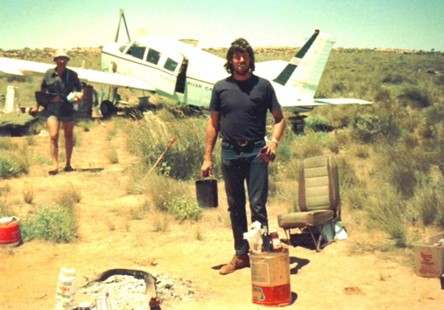|
Oct
24
2022
|
|
Posted 3 years 48 days ago ago by Admin
|
|

I am in awe of aviation mechanics. I have always admired their ability to fix complex and even not-so-complex machines by wading through, what are to me, confusing-to-understand thick, cumbersome maintenance manuals.
One of the most accomplished helicopter mechanics, or engineers as they’re called in Australia, that I ever had the pleasure of knowing was a 60-year-old Australian helicopter engineer by the name of Keith Angel. Keith became my first civilian boss after I left the U.S. military. He hired me to fly his brand-new Hughes 300 to herd cattle in the Northern Territory.
That old fox had an innate ability to fix anything, and I mean anything. I witnessed his uncanny mechanical aptitude when he purchased a Cherokee-6, sight unseen, that had run out of gas and crashed in the remote Simpson Desert, 72 miles south of the tiny Outback town of Bedourie, population 14. Under his tutelage, he and I set off to rebuild her where she crashed with the idea of flying her out similar to the movie Flight of the Phoenix.
This adventure began in 1974 in the days before GPS, so we navigated using simple dead-reckoning skills, flying on time, distance and heading using a World Aeronautical Chart where one inch equaled 14 miles.
Fifty-five minutes out of Bedourie, where we’d refueled at a car gas station, Keith looked at the chart and said, “We’re getting close, mate.”
A glint suddenly caught my eye. Keith pointed, “Bloody hell, man, there she is!”
The crippled green-and-white airplane came into view. I landed the chopper 30 yards from the aircraft.
Keith’s initial inspection revealed that she had a bent prop; both of the main landing gear were twisted, the engine basket holding the engine onto the airframe was bent, the nose gear was completely buckled under and the left wing flap was ripped and torn.
Keith concluded, “We’ll have to do a run-out check on the engine to see if the crankshaft’s bent. If it is, we’ll have to dismantle her and fly the pieces to Bedourie, truck the parts back to Brisbane and rebuild her there.
But, if the crankshaft isn’t bent, we’ll fly the damaged parts by chopper to Bedourie, truck in the replacement parts to Bedourie, then when they arrive we’ll fly the new parts here by chopper, install them, build an airstrip, then we’ll bring in a pilot to fly her out.”
We spent the remainder of the day in 120° heat disassembling the plane’s “bingled bits,” as Keith called them. After disconnecting the mechanical, electrical, fuel and oil connections to the engine, with a make-shift A-frame we lowered the engine onto a tarp. With the propeller removed and using a dial indicator, Keith got on his knees to perform a run-out check on the engine to determine if the crankshaft had been bent.
I stood over Keith anxious to hear his verdict. Without looking up he said with a wry tone, “You know, the sun’s rays have to travel 93 million miles and there’s always some bastard to block the last three feet.”
To our great relief the crankshaft hadn’t been bent in the crash. “We’ll fly her out from here!” Keith announced happily.
The following day, I made several 55-minute ferry flights to Bedourie carrying the broken parts, some underslung, that would be trucked to Brisbane for replacement.
When I flew back to the campsite on my last flight of the day, Keith had inhibited the engine’s cylinders, squirting oil into each one, then covered it up with a tarp awaiting our return when the new parts arrived.
Five weeks later, the new parts arrived at the Bedourie post office which I ferried out to the crash site. Keith hired a pilot, Gary Doyle, to fly the plane out once we’d installed the new parts.
It took all three of us one full day to install the left and right main landing gear. Gary spent most of the time asking Keith nervously, “Do you really think this’ll work, Keith?”
“She’ll be right, mate, no worries.”
Keith noticed the skin on top of the left wing was rippled. He told Gary he was pretty sure the main wing spar wasn’t damaged but unwilling to take any chances he added five feet of angle iron to the underside of the left wing using pop rivets. This unnerved Gary no end. “Do you really think this’ll work, Keith?” he kept nervously asking.
“She’ll be right, mate, no worries.”
The second day we bolted the engine to the engine basket. Using an A-frame and block and tackle we hoisted the whole works in a position, nose gear and all, where we could bolt the engine back onto the airframe.
Keith’s method used for installing the tangle of disconnected electrical, mechanical, and oil lines was brilliant. With no maintenance manual we asked Keith, “Where do we attach all this stuff?”
He answered, “Just pull on the wire, linkage or hose until it won’t stretch any further then look for a place to install it.” Gary and I were amazed that his method actually worked.
Gary noticed the firewall had been caved in restricting the movement of the rudder pedals. “No worries,” Keith said. He climbed in and proceeded to bang the firewall back with a large ball-peen hammer.
Between bangs Gary hollered, “Are you sure this’ll work, Keith?”
Keith hollered back between bangs, “No worries, Gary.”
Keith filled the tanks with 35 gallons of fuel, and hooked up the two 12-volt batteries in series that we’d brought with us to the external power plug on the airplane. Gary primed the engine, called out, “Clear!” and turned the key while Keith and I stood in the desert with fingers crossed, holding our breath.
The engine sputtered and coughed a few times then emitted a cloud of white smoke and the engine roared to life. The three of us yelled in jubilation.
“Now, to build an airstrip,” Keith announced optimistically.
After we shoveled for an hour our airstrip was four feet long and barely wide enough for the width of the plane’s main landing gear.
“We need another plan,” Keith concluded.
On numerous flights in and out of the crash site, I’d noticed a dry lake bed a half mile to the south. The BIG question was could we get the plane over to it? Faced with the prospect of digging forever in the unrelenting heat we opted to give it a try. Keith checked his watch, “I think we can make the Bedourie pub before nightfall if we move quickly.”
I hopped into the helicopter and began shuttling supplies from the campsite to the lake bed while Gary began the extremely slow process of taxiing the aircraft over the hard-packed, mogul-ridden terrain with Keith walking backward in front of the aircraft directing Gary with hand signals over less rough terrain. To everyone’s great relief Gary made the trip without dinging the prop or getting stuck.
I completed the last trip ferrying our gear from the campsite to the dry lake bed. Gary positioned the plane into the wind. With engine idling, he set the brakes and got out. We loaded our remaining gear into the plane then gathered at the left wing.
“How do you feel about this, Gary?” Keith asked earnestly.
“I’ll see you both at the Bedourie pub in 40 minutes,” Gary said.
Keith gave Gary a hearty handshake with both hands and wished him good luck saying, “Randy and I will follow you in the chopper.”
“Are you really sure this thing’s OK to fly?” Gary asked with a big grin.
“Godspeed, mate,” Keith said. “I’ll buy your first cold beer in the Bedourie pub.”
“Keith and I ran to the chopper and watched as Gary advanced the plane’s throttle to takeoff power. The aircraft rocked forward against the brakes. I held my breath as the plane slowly accelerated and roared down the dry lake bed causing a wall of dust to obscure its path from view.
Finally, the plane emerged from dust cloud and rose gracefully slowly climbing for altitude. Keith and I, jumping for joy, let out a combined yell that the 14 residents in Bedourie had to have heard. We screamed and yelled like two madmen consumed by the desert heat.
About Randy:
Randy Mains is an author, public speaker, and a CRM/AMRM consultant who works in the helicopter industry after a long career of aviation adventure. He currently serves as chief CRM/AMRM instructor for Oregon Aero. He may be contacted at [email protected].

READ MORE ROTOR PRO: https://justhelicopters.com/Magazine
WATCH ROTOR PRO YOUTUBE CHANNEL: https://buff.ly/3Md0T3y
You can also find us on
Instagram - https://www.instagram.com/rotorpro1
Facebook - https://www.facebook.com/rotorpro1
Twitter - https://twitter.com/justhelicopters
LinkedIn - https://www.linkedin.com/company/rotorpro1